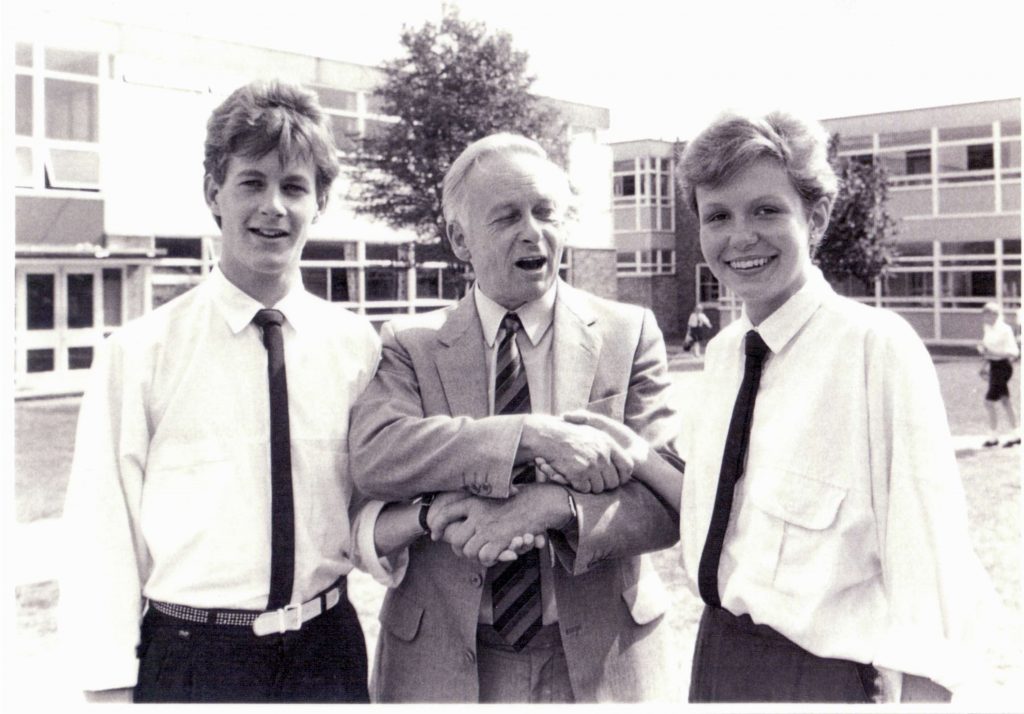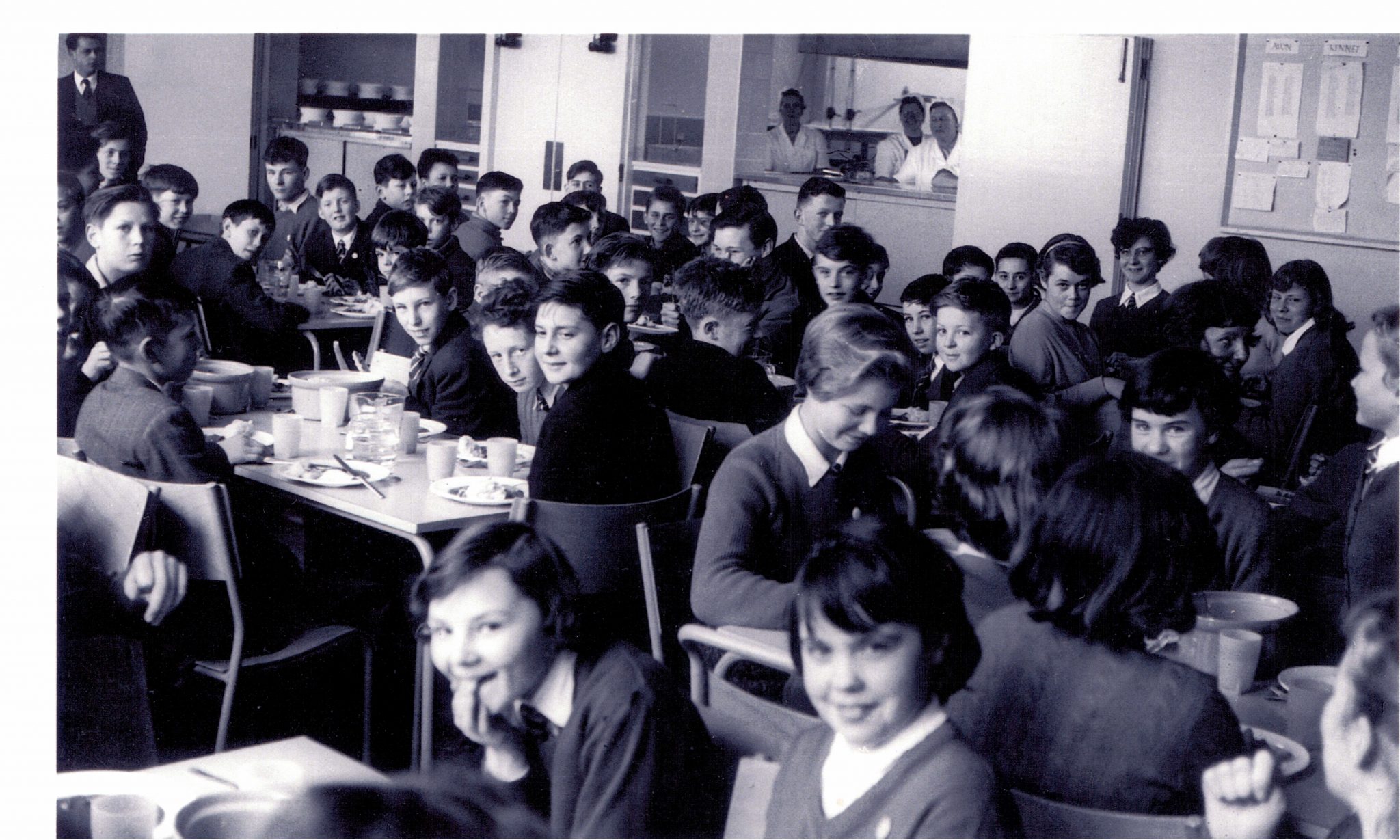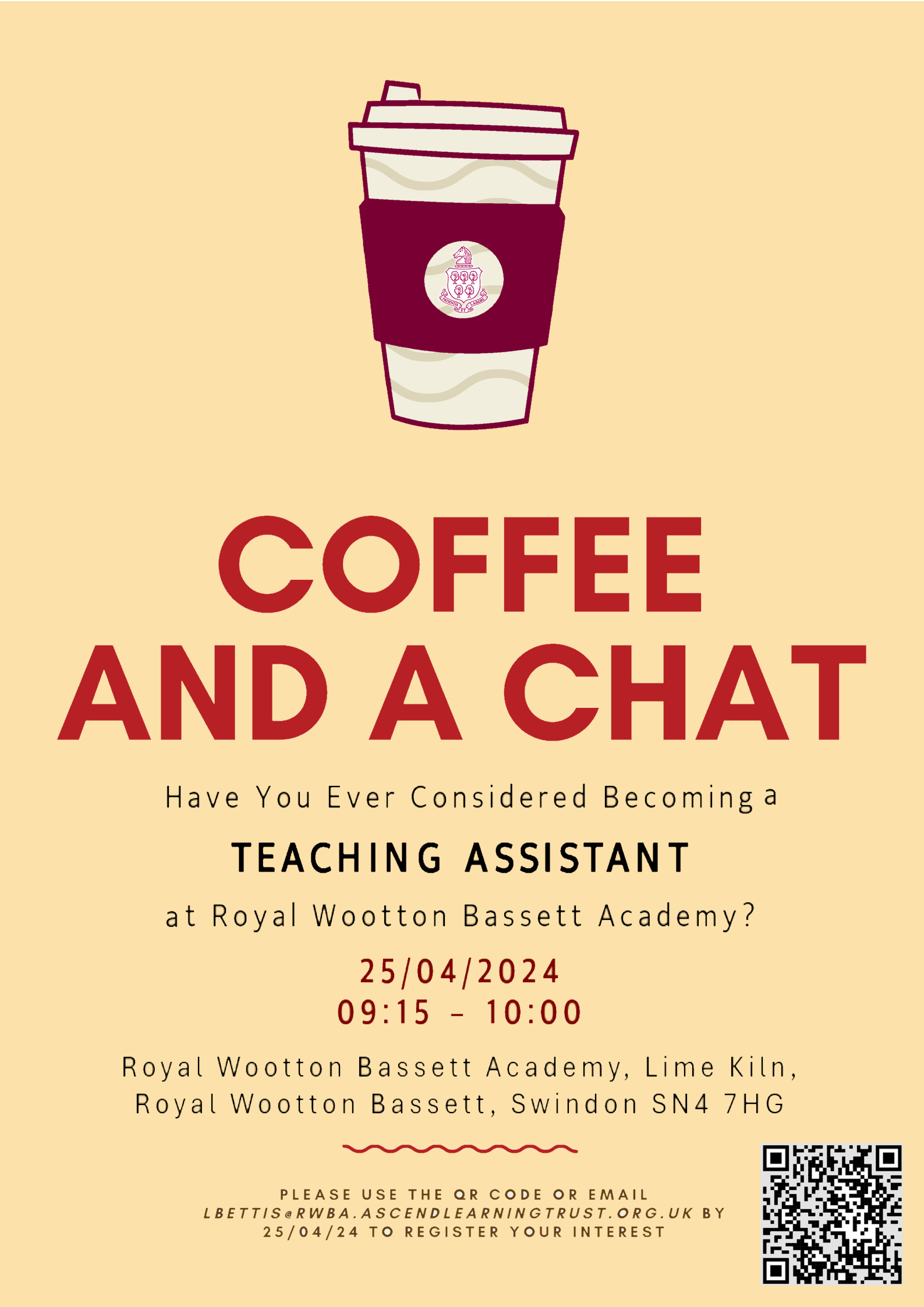History, Headteachers & Houses
History
After the Second World War ended in 1945, Wootton Bassett’s population increased from the estimated 2,800 residents. Wootton Bassett was a dormitory town for Swindon, which saw rapid expansion in the post-war years and several new housing estates. The growth of Lyneham encouraged more shops and businesses to open in Wootton Bassett, and the planned motorway system brought the M4 directly between Swindon and Wootton Bassett.
The Wootton Bassett County Secondary School opened on Wednesday, 8th January 1958, with 279 pupils aged 11 and above, transferred from the two local all age schools and six schools in local villages. Most areas at that time had all age schools; Purton continued to have an all age school until 1962.
There were thirteen staff (eight men and five women) together with the headmaster, Mr F W King. A short service in the assembly hall was conducted by the vicar, the Rev J Goodman, and the Methodist minister, the Rev F Willcox, both governors, to start the first term.
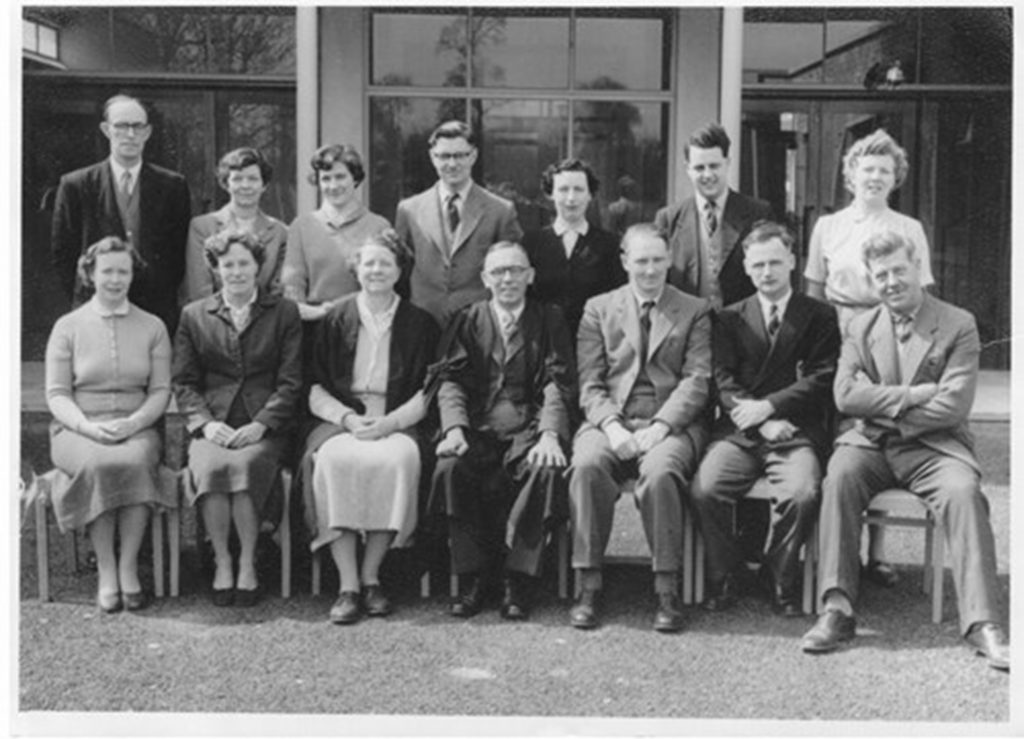
Back row: Mr R Hopkin (special needs), Mrs J Giles (school secretary), Miss E Knights (Rural Science), Mr K Gore (RI and English), Mrs M Maidment (Needlework), Mr G Francis (Music), Mrs E Parrott (Geography)
Front row: Mrs E Trotman (Domestic Science), Mrs K Ball (General subjects), Mrs I Tullett (Deputy Head and Science), Mr F W King (Headmaster), Mr L Brooks (Senior Master), Mr J Horn (English and History), Mr F Upton (Handicrafts).
On March 11, 1958, the first visit of a School Inspector took place. Mr King wrote in the school log book, “Miss Sayers, HMI, arrived at 1.15 and spent two hours inspecting the building, and later stayed with Mrs Trotman, in the Housecraft Room. Miss Sayers is a specialist in Domestic Science. The visit was informal and ended in an amiable atmosphere at 3.10pm.”
The official opening of the school, by the Rt Hon Sir David Eccles, KCVO, MP, President of the Board of Trade, took place on Friday 23 May 1958 at 2.30pm. The vicar and Methodist minister officiated. Most pupils had a day off, but sixty who were in the School Choir, entertained. They sang ‘England’ by Parry, ‘Greensleeves’ and ‘Now is the Month of Maying’. Thanks were expressed by Mr H J Eveleigh, Chairman of the School Governors. About 400 guests, including Mr J H Bradley, the Chief Education Officer, and Mr W E Stevens, chairman of Wiltshire Education Committee, had tea afterwards. A large iced cake, in the shape of an open book, bore a model of the school badge was baked by Pam Cook, the first school cook. Mr King wrote, “Altogether, today has been the most important and successful day so far in our school’s life.”
On July 25, 1958, the twenty-eight school leavers had all found employment. The school’s first full year began on September 8th, 1958 with 352 pupils and 14 staff.
In 1960, Wootton Bassett Secondary School won Wiltshire Schools’ first cross country championship, which took place at Upper Stratton. Robert Pearce subsequently represented Wiltshire at the Schools National Cross Country Championships in Liverpool. In June 1960, he won the 15-17 years Mile race at the County Sports in Devizes and was selected to run for Wiltshire in the South West Championships at Bath. The school gym was built in 1961, when there were 484 pupils. From 1961 to 1981, the town of Wootton Bassett grew from a population of 4,400 to 10,600 and the school rapidly expanded during these dates.
The Log Book notes: On 7th July 1964, Lady Helen Asquith and Mr Sheppard, HMI’s, visited the school. “They remained until 5pm, talked with most of the staff and discussed most aspects of the school curriculum and organisation. Both had lunch in the Domestic Science flat. A long discussion with the Headmaster followed the end of school, from 3.45 until 5pm. On 8th July, Mr Sheppard visited again and stayed until midday. He seemed well pleased with much that he had seen, and was very satisfied with the discipline, uniform and tone of the school.
Mr L F Brooks was acting headmaster in the autumn term, 1967, following Mr King’s retirement in the summer. Upon his retirement, Mr King presented the school with a reading desk and a 120-year-old Bible with a decorative bookmark made by Mrs Kind in the school colours, to remind future generations of the school’s first headmaster. Mr D C Shepherd was appointed as the school’s second headteacher in 1968, having had experience in reorganising Kingsdown School into a comprehensive. Our school was reorganised as a comprehensive in 1972 and was renamed Wootton Bassett School, and many more staff joined. New buildings for Science, Music and Library, together with the Sports Hall, Swimming Pool and a new Sixth Form Centre were built in 1972.
In 1973. The Sixth Form marathon bed-push set a world record by pushing the beds almost 725 miles around a course in the school grounds. The previous record was 644 miles.
After eighteen years, Mr Shepherd retired in July 1986 and Mr J H Thomas was appointed as the school’s third headmaster. With a rapid expansion of the school, numerous mobile classrooms and the deterioration of the buildings, in 1999 funding was agreed by Wiltshire County Council to build three new schools in North Wiltshire at a total cost of £140m as part of a Private Finance Initiative with the White Horse Education Partnership. Wootton Bassett School was to be rebuilt on the site of its playing fields.
When Mr Thomas retired, Mr C C Montacute became the school’s fourth headteacher in September 2001. Wootton Bassett School moved into its new, purpose built £15M accommodation in February 2002. The new facilities include a large library learning centre, fully networked classrooms, a recording studio, a suite of fully equipped technology workshops and modern science laboratories. In addition the school has extensive playing fields, a floodlit all-weather pitch and the use of the adjacent sports hall and swimming pool. The new school building was officially opened by HRH The Princess Royal on 30th September 2002, who would return again on 19 October 2011 to present the Letters Patent on behalf of Her Majesty, The Queen for the town to be renamed Royal Wootton Bassett in recognition of the role the town played during the repatriation of UK military personnel killed whilst serving in Afghanistan.
Wootton Bassett School achieved Technology College status in February 2004.
Mr Montacute left Wootton Bassett School in December 2009 to become Strategic Director at The Schools Network (formally the SSAT), and Mr G A Croxford was appointed as the school’s fifth headteacher. Mr Croxford successfully led the school to be graded outstanding in every category in the November 2010 OfSTED inspection and is thought to be the only 11-18 school in the country to have achieved the result under that inspection framework.
The school converted to Academy status on 1st July 2011, giving it greater control over its curriculum and finances, and was renamed Royal Wootton Bassett Academy on 14th March 2012.
Headteachers

FRANK KING – HEADTEACHER JANUARY 1958 – JULY 1967
The first Headmaster of Wootton Bassett County Secondary School, Frank King, was born in Northampton in 1907. At the age of sixteen, he became a pupil teacher and he read for his degree at Reading and in London Universities. In 1936 he was awarded an honours degree in English. During the Second World War he became a pilot officer in the RAF and he always had a wealth of stories to tell to recently appointed members of staff. His teaching career included being a Senior English Master at Trowbridge Grammar School for Boys from 1937-39 and from 1946-49. From Trowbridge he moved to Nailsea and Scunthorpe before teaching English at the Weston-super-Mare Grammar School for Boys from 1954-1958. In January 1958 he became headmaster of the new Wootton Bassett County Secondary School which he led with great distinction for almost ten years, and always encouraged pupils to aim for high standards in the personal life, academic work and sport. He retired in 1967 at the age of 60.
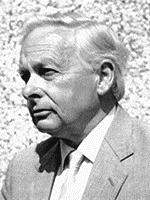
DONALD C SHEPHERD BA(HONS) – HEADTEACHER 1968 – JULY 1986
After qualifying as a teacher, Donald Shepherd served in the Intelligence Corps in the Far East before working as a resident assistant master at Chetham’s School, Manchester. Experience in boarding schools in Essex and Kent was followed by appointment as Deputy Headmaster of Church Central School, Bury. In 1959, he became Headmaster of Crompton House School, Shaw, Lancashire, and in 1964 he re-organised the Kingsdown Comprehensive School. As Headmaster at Wootton Bassett from 1969, he was responsible for the re-organisation of the school into the Wootton Bassett Comprehensive School in 1972. As a Headmaster he had a very individual, forceful style and motivated both staff and pupils to work hard. He also made valued contributions to the local entertainment scene, in the spectacular annual pantomimes which he wrote and directed. After 18 years of devoted service he retired in 1986 to Grange-Over-Sands in Cumbria.
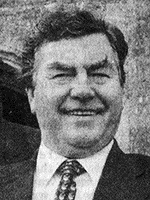
HYLTON THOMAS OBE MED FCP MBIM – HEADTEACHER SEPTEMBER 1986 – JULY 2001
Born in South Wales, Hylton Thomas attended schools in Bristol and Merthyr Tydfil before studying Metallurgy at Cardiff University. He worked in the Steel Industry before switching to teaching in the mid-sixties. Mr Thomas Taught at schools in Somerset and Avon, then joined the Service Children’s Education Authority as Deputy Head of Kings School, Gutersloh in West Germany. He became Head of Gloucester School, Hohne in 1982, returning to the UK to take up the Headship of Wootton Bassett in 1986.

CHRIS MONTACUTE BSC(HONS) MBA FRSA EXECUTIVE – HEADTEACHER SEPTEMBER 2001 – DECEMBER 2009
Chris Montacute joined Wootton Bassett School at a point of momentous change when the school was moving lock, stock and barrel from its rather tired old premises into a new 21st century building. He was previously headteacher at Bradon Forest School (1997-2001) and deputy headteacher at Cirencester Deer Park School (1992-97). Under his headship, Wootton Bassett School has gained Specialist Status in Technology, introduced the International Baccalaureate as an alternative to A-levels and raised £3m for a new sixth form centre. He was awarded the RAF Award for Headteacher of the Year in a Secondary School at the Teaching Awards in 2005.

GEORGE CROXFORD BA(HONS) HEADTEACHER – JANUARY 2010 – APRIL 2020 CEO ROYAL WOOTTON BASSETT ACADEMY TRUST
Originally from Ashford in Kent, George Croxford has been a PE teacher for over 25 years and has spent the last eighteen years in Senior Leadership. He moved to the South West in 1993 and his experience has always been “in very challenging schools”. His previous role was Headteacher at the Bridge Learning Campus Bristol (Hartcliffe) where results improved from 9% 5 A*-C including English and Maths and 17 % 5 A*-C to 38 % and 63% after 4 years. In the OfSTED inspection of November 2010, he successfully led Wootton Bassett School to become Outstanding in all 27 categories; the only 11-18 school to achieve this under that framework. During this time, Wootton Bassett School converted to an Academy, and he ensured that Royal Wootton Bassett Academy retained its Outstanding designation when reinspected in November 2013. RWBA was rated as one of the best in the whole of the south west region during his headship in The Sunday Times. He was shortlisted for the best secondary school headteacher in 2019 by the Pearson National Teaching Awards. Royal Wootton Bassett Academy Trust was established in May 2017, with George as its CEO. He left the position of Headteacher to take on the role of CEO at the Trust full time.
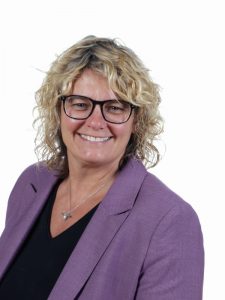
ANITA ELLIS BA (HONS) – HEADTEACHER APRIL 2020 – PRESENT
Anita Ellis joined the school in 2001 as as a newly qualified teacher of history and sociology, and has held many positions of leadership during her time at the school, as Head of Phase, then Assistant Headteacher, Deputy Headteacher for eight years before becoming the Academy's first female Headteacher, of which she is very proud.
Houses
When Wootton Bassett Secondary Modern School opened in 1958, a house system was soon introduced and the pupils were placed in one of four houses which were named after four of Wiltshire’s rivers: Avon, Isis, Kennet and Wylye.
On the arrival of Mr Shepherd in 1968, the school population had grown considerably from the original 279 and he decided to increase the number of houses from four to six and also to introduce new names. The names chosen were those of families who had been influential in the town and the surrounding areas. They were Bassett (green), Bolingbroke (blue), Clarendon(yellow), Crispin (white), Goddard (orange) and St. John (red).
The school numbers continued to increase and in 1972 three more houses were added – Despenser (maroon), Englefield (black and white) and Langdon (light blue and white).
CRISPIN
Miles or Milo Crispin was the powerful Norman baron who had inherited many estates from his father-In-law, Robert d’Oigli. One of these estates was the manor of Wodeton. We can read in the Domesday Book of the nature of this holding ploughland, pasture, woodland, number of labourers etc. The water mill was probably that known later as Hunts Mill, which only recently has been obliterated.
DESPENSER
The Despensers connected with Wootton Bassett belong to the 13th and 14th centuries and were all called Hugh. The first one acquired the Bassett estates by marrying Aliva, the Heiress of Sir Philip Bassett. He was killed at Evesham in 1265, fighting for Simon de Montfort. His son was an able and ambitious man who rose to become Earl of Winchester. His rapid rise excited the jealousy of the other barons, who were still more affronted when Hugh III became the favourite of the king, and shamelessly exerted his authority over everybody, including the Queen. Local examples were his seizure of 600 acres from Midgehall Manor, and the imprisonment of Henry of Hook, whose land he coveted. In 1321 the Despenser temporarily fell from power, and his enemies stripped his properties at Marlborough and Vastern of almost everything of value. They returned briefly to favour but shortly after were overthrown and ruthlessly executed. Richard II was deposed and murdered in Berkeley Castle. A Despenser of more magnanimous spirit was next in line. In the Crecy campaign when Edward Ill’s army was almost trapped the king trusted the Despenser sufficiently to give him the vital task of finding an escape route across the river. There seemed to be some special quality in the Despenser make-up for in later years they continued to make their mark in the national life, usually in more peaceful ways.
ENGLEFIELD
Francis Englefield of Englefield House near Reading had been a resolute defender of Mary Tudor’s interests when she was harassed by ultra-Protestant emissaries of the Protector, Somerset. When she became Queen she granted him a pension and the manors of Vastern and Wootton Bassett, which seems to have pleased him mightily for we read that when attending Court he would parade the streets of London with never less than 100 retainers. On Elizabeth’s accession he refused to acknowledge her and was forced to flee the country. His Wiltshire estates were given to his cousin Francis II, who continued his predecessor’s policy of enclosing common land, so much so that the townsfolk complained bitterly. The Englefield connection ended when Sir Robert Howard married the widow of Sir Francis IV and on her death sold the manors to Lawrence Hyde in 1676.
ST. JOHN (usually pronounced “Sinjon”)
The family took its name from St. Jean-Ie-Thomas in Normandy, and became established in Lydiard when Oliver St. John married Margaret Beauchamp, a descendant of the Tregoz family, about 1430. Margaret’s second husband was John Beaufort, Duke of Somerset, by whom she had a daughter who became the mother of Henry VII. Not all St. John’s were “king’s men”. Carlyle records how one of them, “a dark tough man, of the toughness of leather” defended John Hampden for 3 days in the Ship Money trial. The family had great influence in the district and reacted violently to Lawrence Hyde’s, attempts to sway the Wootton Bassett elections in his favour. There was another branch of the family in Battersea.
BOLINGBROKE
This is really a continuation of the St. John story and derives from the fact that the most famous member of that family, Henry St. John, was created Viscount Bolingbroke in 1712, from which date the title passed down the generations until the male line was extinguished a few years ago. The title but not the house, which was bought by Swindon Corporation in 1943, is now borne by a distant cousin who lives in New Zealand. Henry St. John started his political career as M.P. for Wootton Bassett in 1701 and by his brilliant oratory and political acumen soon became the leading statesman of the day. He was also a master of the grand style in literature which earned him the friendship of such writers as Pope and Swift. Intrigue with the Jacobites abroad, a favourite ministerial pastime, caught him out when Queen Anne died suddenly, and he had to go into exile.
CLARENDON Edward Hyde. M.P. for Wootton Bassett in 1640 was made Earl of Clarendon for his devoted service to the Stuart kings. Charles I and II. During his second exile he wrote the “History of the Great Rebellion”, profits from which were used to found the Clarendon Press in Oxford. His daughter married James, Duke of York, and became the mother of two queens. Mary and Anne. Their uncle was Lawrence Hyde whose ownership of the manor of Wootton Bassett ensured that the name “Clarendon” was associated with the town untiI 1866 when George William Frederick Villiers, 4th Earl (2nd. creation) sold out to the Meux family. He was a famous Victorian statesman and there is 8 memorial window to him in the Parish Church.
LANGDON
Not much is known about the early life of Valerie Susan Langdon (or Reece) except that she was a great beauty (see her portrait in the Town Hall) and acted with success at the Comedy Theatre, London. In 1879 she married 51 r Henry Bruce Meux. It was her second marriage. After a tour to the Middle East she became a considerable collector of Egyptian antiquities which were housed at Theobalds Park in Herts. Other activities included breeding the Derby winner for 1901, presenting a battery to the nation during the South African War and in general showing an independence of spirit not often met with in those days. One story tells how, after a fancied slight from the M.F.H. of the Beaufort Hunt, she turned up at the next meet riding on an elephant. She conferred many benefits on Wootton Bassett and, as a parting gift, gave the Town Hall which her husband had renovated at such cost in 1889.
GODDARD
The family originally came from Aldbourne, and in 1562 bought the manor of High Swindon. During the next six generations they exercised an increasing influence on the whole area and were the dominant landlords. With the coming of the railway age this influence declined and in 1943 their principal residence. The Lawn, was sold to Swindon. The house has now been demolished but the grounds remain as a public park. Another branch of the family is of closer interest. It owned the manor of Clyffe Pipard and from 1780 to 1935 provided all the vicars, the most notable of them being the Reverend E. H. Goddard who, from 1890 until his death, acted as honorary secretary, editor and librarian to the Wiltshire Archaeological Society. He set an example of public service which it would be hard to surpass.
When comprehensive education was in introduced the school’s annual intake number was estimated at about 300 but the actual number was about 250 and by 1977 it became very difficult to staff nine houses. Reluctantly, it was decided that Bassett house should no longer continue and that its pupils and staff should be assimilated in to the eight other houses. For many pupils and staff, this was a painful time, but since 1977 the school continued with eight houses until 1992. The house system was reorganised in 1992 and were renamed after four of the local ‘Bassetts’. These were Berwick (blue), Compton (yellow), Winterbourne (green) and Wootton (red).
When the school was granted Technology College status, the houses were renamed in 2008 by student vote after noted technologists and entrepreneurs. The new names were: Brunel (green), Newton (yellow), Roddick (blue) and Whittle (red).
In March 2012, the school converted to an Academy and did not continue with the Technology College status. As the Academy’s population grew, an additional fifth house was created to cope with the dramatic increase in student numbers. The house names reverted to Berwick (blue), Compton (yellow), Winterbourne (green), Wootton (red) with the addition of Bassett (purple) in 2014 after students and staff voted to do so.
Notes on Wootton Bassett School Houses 1968 – 1992 by P J Gingell
